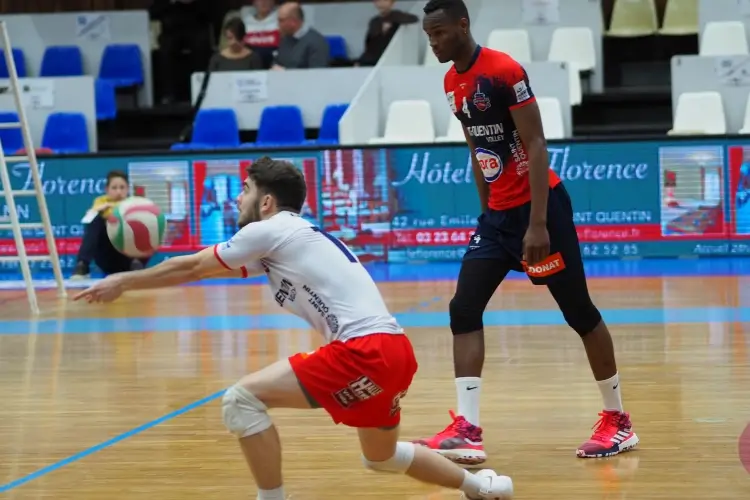Last Updated: October 19, 2023
Players with solid passing skills will have no trouble edging out their competition. No doubt, the ability to receive the ball clearly and maintain its control sets the foundation for a successful pass.
Successful passes allow the setters and hitters to execute their plans well, improving the chances of team success in the process.
Whether you are a beginner or not, here are some expert strategies for effective ball reception.
Efficient Receiving and Passing Strategies

Keep looking at the ball
Opposing players often build a wall at the net to block the view of the volleyball. You should still find a way to get an unobstructed view of the ball. For maximum ball visibility, you must keep looking at it before it even connects with the server’s hands.
By watching the ball early when it has not crossed your side of the net, you can predict the type of serve coming your way before the ball’s reception. So, there will be fewer unpredictable surprises in store for you, making it less challenging to defend the team scores.
You will also be able to adjust your position quickly according to the incoming serve by constantly looking at the ball. When handling a difficult serve, you will get a few extra seconds to receive or pass the ball efficiently.
Maintaining visual contact with the volleyball will not only enhance your ability to receive the ball but will also help you make accurate passes. Therefore, you must not lose sight of the ball, even during long and intense matches.
Get into position early
Getting into position early can greatly improve your passing game because it will help you judge the ball better, allowing you to react accordingly. The sooner you can judge the ball, the faster you will be able to respond.
To move quickly in any direction and to gauge the ball’s trajectory, you must carefully observe the server’s arm swing and body language. You will have to react as soon as the ball connects with the server’s hands.
You must take quick and small steps to adjust your body according to the approaching ball in a ready stance. Your feet should be shoulder-width apart, and there needs to be a slight bend on your knees.
You must also be on your toes because it enhances the reaction time when receiving or passing the ball. Proper toe positioning helps absorb the ground impact through the legs, reducing stress on the upper body in the process.
Anticipate the ball to be yours
This tip emphasizes mental alertness. To remain focused, you should expect to be the one to receive the ball every time the opponent touches the ball. You must remain mentally engaged to react even when the volleyball is far from you.
This will help you remain prepared for an effective serve return when the ball’s trajectory changes unpredictably. In other words, you will be more adaptable to handle unexpected situations, which can be very helpful in tight matches.
Being ready also fosters a good team environment, as your readiness will motivate others in your team to give their best shot. It will help them believe they can handle the incoming ball in every situation.
Provide a big platform
To have maximum control over the ball, the incoming ball must connect with the meaty portion of your forearms. You must receive the ball on the lower part of your forearms, and not on the wrist and finger area.
Your arms should be stretched out (with a slight bend) to provide a larger surface area for ball reception. Maintaining a slight bend will work well for passing the ball because the bend in the elbow will help absorb the impact from the incoming ball.
That said, the elbows must not be overly bent. When the ball connects with your hands, you must lock your wrists together with your thumbs pointing downwards, and not towards the sky. This will ensure that the ball does not go in any unintended direction.
Deciding where to pass the ball
A player responsible for passing should have good situational awareness. In other words, the player should know what is going on around him, including where other teammates are positioned on the court.
If the setter is standing close to the net, you should aim to provide a higher pass. If the setter is further away from the net, you should focus on passing the ball accurately to the setter. If a hitter is better positioned to strike an attack, you should aim your pass toward the hitter.
As it’s easy to tell by now, good situational awareness will help you make quick and well-informed decisions. Therefore, you should put conscious efforts into expanding your vision. You should start looking beyond the volleyball.
During practice drills for improving your passing and receiving skills focus on your situational awareness, too, by paying attention to what your teammates and opponents are doing.
Train in off-balance positions
You won’t be a highly skilled volleyball player unless you expose yourself to training in off-balance positions. After all, off-balance training comes close to mimicking real-game situations, allowing you to handle the ball well in unpredictable conditions.
So, create drills that replicate real-game scenarios. For instance, practice receiving serves from different angles and locations. Instruct your partner to keep changing the ball’s direction to help you develop quick reflexes.
You can keep increasing the difficulty level of the drills to master off-control balance. Over time, this will help you develop quick and precise footwork to recover smoothly from off-balance situations on the volleyball court.
Practice on both feet
Many players practice moves mainly with their predominant foot. In other words, they usually don’t train both legs equally. As a result, the weaker side keeps getting weaker, which impacts their performance.
Players who practice with both feet get far more versatile than others. Regularly training the weaker leg allows them to make quick adjustments through either side of the body to receive or pass the ball effectively without any fuss.
It helps them move more fluidly around the court, enabling them to react well to very unpredictable balls. It also saves players from overuse-related injuries associated with muscle imbalance, caused due to one side of the body being weaker than the other.
So, it helps to incorporate drills that involve the non-dominant feet as well, allowing you to be a proficient passer even when using the non-dominant side of the body for passing. To see improvements, it will take time. However, it will be worth the wait.
Work on your shoulder mobility
You need mobile shoulders to be good at volleyball receiving and passing. Good shoulder mobility comes in extremely handy in difficult situations when you must reach out to exceptionally high or low serves.
Mobile shoulders also minimize injury risk. Players with stiff shoulders are more susceptible to injuries because of their inability to elevate their arms or generate sufficient force to execute a wide range of volleyball passing activities.
Related: Mastering the Art of Passing: Essential Techniques for Volleyball Players
To maintain good shoulder health, you must strengthen your shoulders through training exercises. You must also do mobility exercises to enjoy a good range of motion. Additionally, you must do warm-up and stretching exercises before and after your practice sessions.
Record yourself
Record yourself during your practice sessions so that you can inspect areas of improvement. Volleyball athletes at the highest level normally record their footage to identify flaws in their skills. It also helps them identify their strong points, which they use to their advantage.
In fact, you can record videos of both your practice and actual matches. Analyzing footage of actual matches will help you evaluate your performance under pressure. You may notice a night and day difference in performance between practice sessions and actual matches.
If possible, record yourself from different angles, which will help you pick certain nuisances you might miss otherwise. When reviewing the footage, focus on one area at a time. For instance, analyze your mistakes in receiving first to see what to work on. Then, evaluate your passing.
The recorded footage will also give you a good opportunity to assess your communication skills. Check if you are communicating well with other teammates because it will impact your decision-making ability on the court.
You can consider sharing the video footage with your coach or other experienced players on the team to help them identify areas of improvement for you. Remember the inputs or maintain a journal to remind you of the areas that require work.
Conclusion
Mastering these volleyball skills will help you receive and pass the ball like a pro. That said, you need to have realistic expectations.
Depending on your skill level, improvements may happen bit by bit and not suddenly. It would still be worth the time and effort. So, keep going even if it takes longer to meet the specific objective. It would be totally worth the enduring wait.
